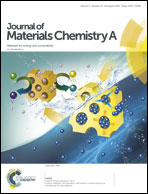The impact of radical loading and oxidation on the conformation of organic radical polymers by small angle neutron scattering†
Abstract
Electrodes comprised of organic polymeric materials containing stable radicals have become attractive for incorporation into organic radical batteries. Specifically, the radical polymer poly(2,2,6,6-tetramethylpiperidinyloxy-4-yl methacrylate) (PTMA) exhibits extremely rapid electron charge transport rates, comparable to traditional transition metal ions. However, the structural reorganization that the polymer undergoes during charging is not well understood. Using small angle neutron scattering, we have investigated the structural changes the PTMA polymer exhibits with variation of radical concentration or oxidation. The results indicate that as the radical concentration is increased, the polymer becomes more inflexible and begins to aggregate with neighboring polymer chains as the radicals on the polymer align with neighboring solvated chains. Additional studies monitor the conformational changes of the PTMA copolymers with oxidation to mimic the structural changes that the polymer undergoes during charging. These results show that polymers with low radical densities are more susceptible to reorientation with charging than a polymer that is fully saturated with radical moieties. This study therefore provides seminal fundamental information that identifies the relationship between radical density and molecular structure providing crucial insight that is needed to improve the performance of organic radical batteries.



 Please wait while we load your content...
Please wait while we load your content...